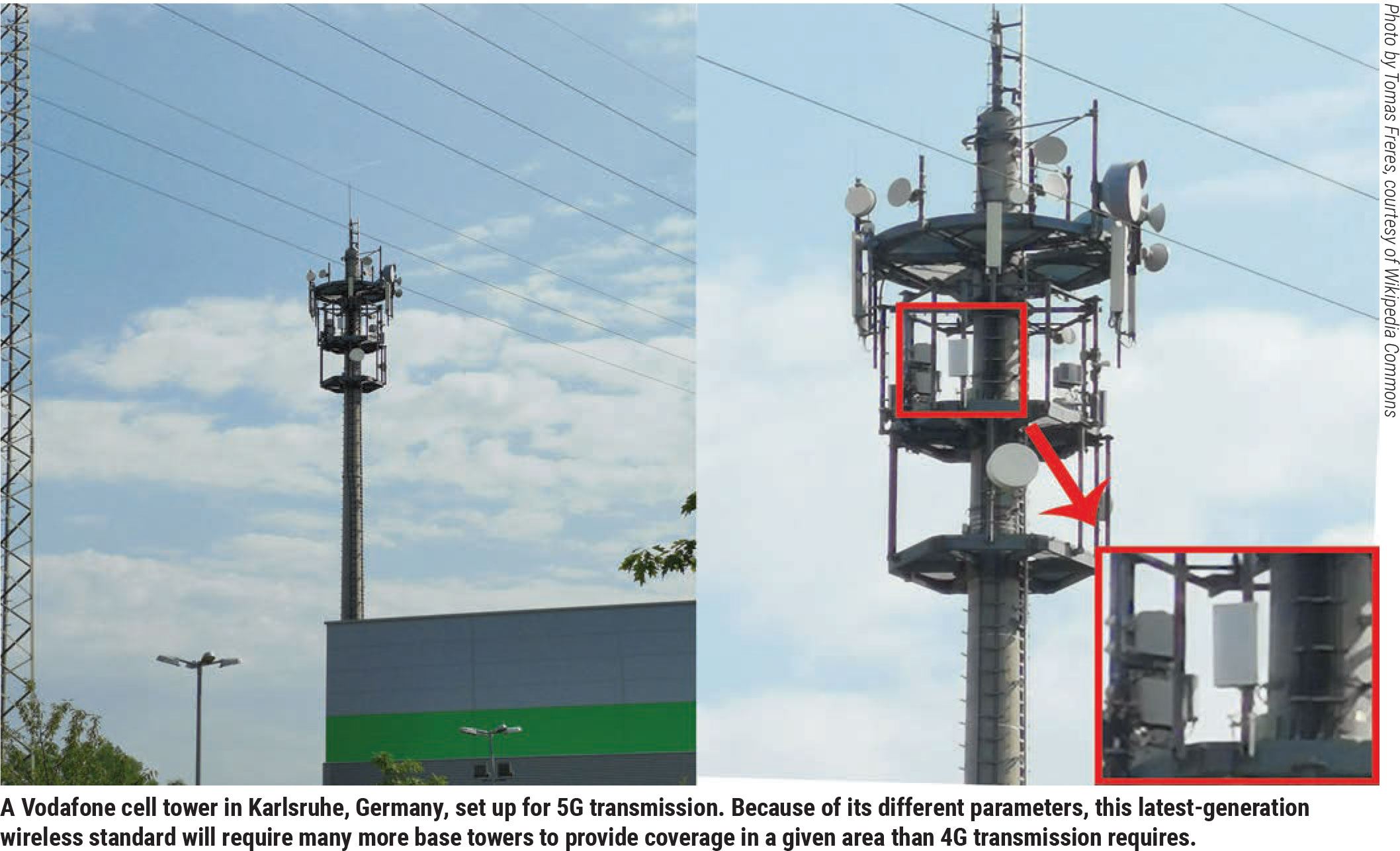It’s no secret that technology is advancing by leaps and bounds every year, and the technology that enables us to communicate via smartphones and the internet is no exception. In recent years most of our communications have been transmitted using what’s referred to as 4G technology—the fourth generation standard for wireless telecommunications. Lately, unless you’ve been hiding under a rock, you’ve been seeing ads on television promoting the use of 5G.
For historical comparison, the first generation, which appeared in the 1980s, was able to deliver sufficient signal to carry analog voice communications. The second generation appeared in the early 1990s, with sufficient speed and bandwidth to carry digital voice transmissions and allow primitive messaging—the precursor of today’s texting. In the early 2000s, 3G allowed the transmission of mobile digital data, making smartphones feasible, and a few years later 4G made mobile broadband transmission possible.
So: What’s the significance of this new fifth-generation standard, and how will it affect the field of ophthalmology?
The Benefits of 5G
5G technology should bring higher transmission speeds, lower latency (i.e., fewer delays) and greater throughput (more data transmitted at once) than was possible with 4G. This should lead to dramatically faster downloading and data sharing, and make it possible for some of today’s newest “smart” technologies to communicate large amounts of data in real-time. 5G uses much-higher-frequency radio waves, which will allow many more devices to exchange data simultaneously within a given area. For example, 4G can support about 10,000 devices per square mile; 5G will be able to support about 2.5 million devices.
 |
Recently, 4G networks have been reaching their capacity in crowded areas such as urban environments. This means that even if you have a good signal (i.e., five bars), the bandwidth may be overcrowded with digital information, making it impossible to access websites or stream music or movies. That shouldn’t happen with 5G. This will be particularly advantageous for today’s smart devices, which share far more digital information than was the case even a few years ago.
Daniel Ting, MBBS, an associate professor at Duke-NUS Medical School in Singapore and head of AI and digital innovation at the Singapore Eye Research Institute, offers some perspective regarding how this may affect ophthalmologists. “Compared to 4G or 3G, 5G has a much faster speed of data transmission, lower latency and a lower power requirement,” he explains. “Medical usage may benefit from 5G largely due to the speed of transmission. For example, outside of ophthalmology, 5G can be used in conjunction with robotic laparoscopic surgeries with technology such as the Da Vinci surgical system.
“In the field of ophthalmology,” he continues, “5G could improve real-time remote consultation or treatment by reducing the lag-time of virtual consultations and AI-enabled diagnostic algorithms hosted in the cloud. Other possibilities such as robotic surgery aren’t currently as widespread in ophthalmology as in some specialties like urology and gynecology, although the use of robotic vitrectomy was described a few years ago. However, the development of virtual and augmented realities to aid with testing and treatment, powered by the cloud and 5G technology, is another potential area in ophthalmology that could benefit from this in the future.”
Potential Downsides
One of the practical challenges resulting from the altered parameters used in 5G data transmission is that it requires the use of far more base stations spread throughout a given area to provide all of its benefits. “The need for, and cost of, increased base stations could be a potential issue for rural areas with sparse populations,” Dr. Ting notes. “Thus, the infrastructure for 5G will need to be developed to make it practical and increase its cost-effectiveness for things like telecommunications, medical usage, cybersecurity and financial data transmission.” It also appears that the new parameters won’t allow transmission inside large buildings such as hospitals and large standalone practices, as some surgeons trying 5G have already noted. (This may be resolvable as a practical problem by combining 5G with the latest WiFi technology, WiFi 6.)
 |
Another issue that’s been raised as a result of the new parameters used in this technology is the possibility that it may be less secure, thanks to its increased complexity, the greater data flow and the use of more base stations than 4G wireless transmission technology required. Among other things, these factors will make it harder to check for vulnerabilities. On the upside, some say the ability to do “network slicing”—dividing up the network capacity to tailor a signal for better encryption and security—could be a boon to security.
“Network security and encryption is extremely important when data privacy is involved,” agrees Dr. Ting. “Given that the 5G applications in health care are not common as yet, we haven’t seen adverse events resulting from malicious hacker attacks so far. On the upside, 5G could be used in conjunction with blockchain technology to increase the cybersecurity of these uses.”
So: Should ophthalmologists be in a hurry to upgrade? “At present, the use of 4G is sufficient to perform our daily activities,” notes Dr. Ting. “However, with more sophisticated technologies coming on board such as driverless cars, drones, and so-called ‘Internet of Things’ devices [Internet-connected devices that collect and transfer data over a wireless network without human intervention], the use of 5G technology could further improve their performance—if the challenges such as the need for increased base stations can be resolved.”
What about security-related concerns? “It will be important to use things like penetration tests to evaluate the strength and vulnerability of these technologies for any digital solutions or telecommunication network,” he says. “I think we should vigorously test this within research settings prior to actual clinical implementation.”



